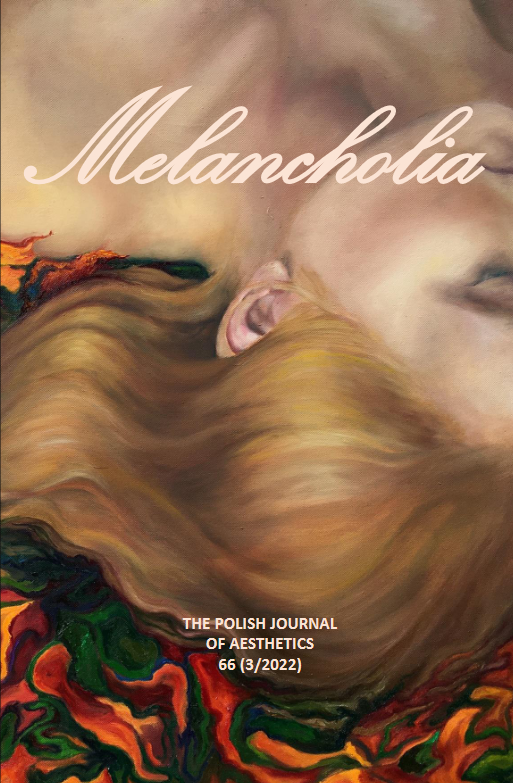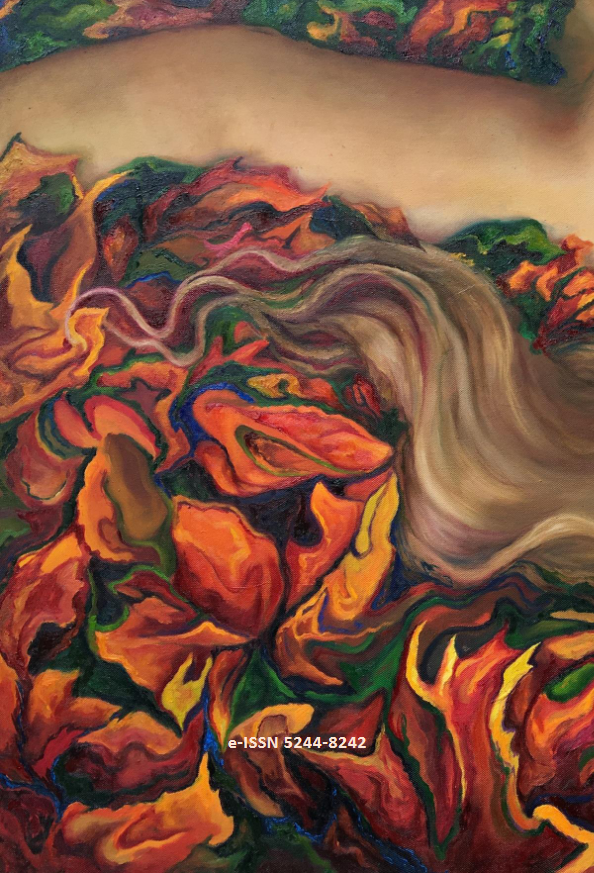Numer 66 (3/2022)
Melancholia|
Spis treści
Strony
Pobierz
|
|||||
|
|
|||||
|
Streszczenie Everyday concepts often carry a unique emotional color, rarely showing any ambivalence. Such is the case with melancholy. The veil of sadness that envelops melancholy can be pleasant and unpleasant, desirable, or unwanted. On one hand, there is romanticism, Chopin's nocturne, an indefinable longing for an unreachable ideal. The memory of lost happiness transports us back to past times, which we only perceive from a distant perspective as the best of what could have been given to us. On the other hand, melancholy is an expression of disappointment, and barrenness, a void that dangerously floods the oppressed soul, emerging from some dark corners of the subconscious... INFORMACJE O AUTORZE
Uniwersytet Śląski w Katowicach
|
|||||
|
Kyle Sossamon
The Phenomenon of Historicist Melancholy in Artistic Research and a Deleuzian Alternative
DOI: 10.19205/66.22.2
11 – 27
|
|||||
|
Słowa kluczowe Gilles Deleuze |Michael Ann Holly |Aesthetics |Melancholy |TransmissibilityStreszczenie In this article, I propose a comparative analysis between two conceptions of artistic research. One governed by historicist melancholy and an alternative model informed by the philosophy of Gilles Deleuze. In juxtaposing these two conceptions of artistic research, I explore their theories of materiality and temporality to locate the nexus of their divergence in the realm of the artwork qua sign and the consequent mode of signaling deployed by each position. I am ultimately pointing to the possibility of an art history informed by the thought of Deleuze as capable of abandoning melancholy as a disciplinary and methodological presupposition for the sake of a different affective power: Spinozist joy. INFORMACJE O AUTORZE
State University of New York at Binghamton, USA
|
|||||
|
Cláudio Alexandre S. Carvalho
Visual Forms and the Therapeutic Medium of Melancholy
DOI: 10.19205/66.22.3
29 – 47
|
|||||
|
Słowa kluczowe Melancholy |Art System |Therapeutic Medium |Albrecht Dürer |Visual SemioticsStreszczenie Considering artworks’ socio-political framework, we explore the therapeutic use of visual artworks to relieve a melancholic condition. The transformative effects of aesthetic artifacts are evident in Durer’s work, intersecting physiological, religious, and political elements in a program for self-knowledge and redemption. We will see that what is proposed is not a simple emulation of the means of curatio verbi but the sketching of a specific semiosis, providing perception with an autonomous pathway for self-transformation. INFORMACJE O AUTORZE
Universidade do Porto, Portugalia
|
|||||
|
Aleksander Kopka
The Image of Mourning: on Melancholic Militancy and Remembrance
DOI: 10.19205/66.22.4
49 – 66
|
|||||
|
Słowa kluczowe Melancholy |Mourning |Deconstruction |Spectrality |SurvivalStreszczenie In this article, I present Jacques Derrida’s reflections on melancholy in the context of his thought of mourning and juxtapose them with ethical dilemmas regarding the image of the (dead) other by focusing on the mournsome character of photography. By adopting Derrida’s conclusion that the work of mourning cannot be successful and melancholy always marks both its teleological failure and structural impossibility, I demonstrate why melancholy as an abnormal yet necessary condition of egoic life should presuppose originary non-presence of the (dead) other. Furthermore, I argue why melancholy, rather than being treated solely as a pathological condition, must be thought of in terms of survival, ethical revolt, and a militant challenge to memory. INFORMACJE O AUTORZE
Uniwersytet Śląski w Katowicach
|
|||||
|
William Engstrand
The Effects of Loss in the Sublime Moment: Jean Pierre and Luc Dardenne’s Le Fils
DOI: 10.19205/66.22.5
67 – 82
|
|||||
|
Słowa kluczowe Loss |Melancholia |Jean-Pierre Dardenne |Luc Dardenne |Sublime |filmStreszczenie Luc and Jean Pierre Dardenne, in their film Le Fils (2002), reveal the sublime through the repetition of the movement/act of watching, which are the temporal shifts between grief, mourning, and melancholia. These movements and acts become, in Judith Butler’s (2002) words, “The very means that loss is registered” (470). Jean-François Lyotard (1994) describes the sublime moment as “at the encounter of the two ‘absolutes’ equally ‘present’ to thought” (123) that can evolve from an ordinary perspective into a sudden awareness of a different perspective. In Le Fils, melancholia is not a state of mind chronologically arrived at as much as it is part of a cluster of loss effects—coupled with grief and mourning—that can be felt intermittently and simultaneously as a way of navigating the impact of loss. This dynamic state, this shifting cluster, unfolds in Le Fils as a disorientation, a metaphysical and temporal precarity. Gilles Deleuze (1986) points out that the sublime moment “is like two presents which ceaselessly intersect, one of which is always arriving and the other is already established” (106). In the context of loss, Deleuze’s “arriving” can be the temporal loss cluster of grief, mourning, and melancholia, while the other present (“already established”) can be loss itself—something that is always present in its effect. Each present exists for the other, one navigating the ongoing impact of the other. Still film frames will be presented like citations of lines from poetry or excerpts from written text to mark the sublime moment’s emergence. I will focus on three such moments in this analysis. INFORMACJE O AUTORZE
Morgan State University, USA
|
|||||
|
Wojciech Wieczorek
Hitchcock and Von Trier: the Operatic Melancholia in Cinema
DOI: 10.19205/66.22.6
83 – 96
|
|||||
|
Słowa kluczowe Melancholia |Lars von Trier |Wagner |Alfred Hitchcock |Herrmann |music |VertigoStreszczenie The paper examines the usage of Richard Wagner’s operatic inventions in 20th and 21st-century cinema and its representation of melancholia and love. The text describes the philosophical ideas that drove Wagner to create Tristan and Isolde and new means of musical expression, which were later used in film music. The first part discusses the use of Wagner’s music in 2011 Melancholia, while the latter studies his influence on Bernard Herrmann’s score for Vertigo. INFORMACJE O AUTORZE
Uniwersytet Śląski w Katowicach
|
|||||
|
Michael Forest
Melancholic Modernism in Jim Jarmusch’s Only Lovers Left Alive
DOI: 10.19205/66.22.7
97 – 107
|
|||||
|
Słowa kluczowe Theodor W. Adorno |Melancholy |modernism |Splenetic |Jim JarmuschStreszczenie The essay explores Adorno’s notion that modernist art is a dialectic between the ideal and the spleen in relation to Jim Jarmusch’s 2013 film, Only Lovers Left Alive. The film tracks bohemian vampires who map onto the idealist and splenetic as modernist aesthetes, setting a mood of gothic melancholy. Retreating from modern capitalism and consumerism—the zombie world in the film—the characters illustrate the film’s succession of binaries in an attempt to retain their purity and manage their concomitant melancholy. Ultimately, they must compromise, and their pragmatic negotiations are telling. The essay explores these concepts concerning the main characters, Adam and Eve, the prominent locations Detroit and Tangier, and the main dialectical concepts of the splenetic and the ideal. Jarmusch’s film extends Adorno’s insightful pairing and updates it for an artistic and social milieu quite different than the one that Adorno wrote from, while Adorno’s concepts draw out the philosophical content latent in the film. Melancholy is expressed as a necessary condition for an adequate post-industrial aesthetic, but it is insufficient for aesthetic survival. INFORMACJE O AUTORZE
Canisius College in Buffalo NY, USA
|
|||||
|
Swagata Chakraborty
Melancholia as an Ecological Entente: Tracing the Ecocritical Significance of the Melancholic Poet Persona in Margaret Atwood’s Dearly
DOI: 10.19205/66.22.8
109 – 127
|
|||||
|
Słowa kluczowe Melancholia |ecocriticism |Freud |AtwoodStreszczenie With a close reading of Margaret Atwood’s collection of poems Dearly, the paper aims at an alternative understanding of Freudian Melancholia to discuss its creative and fecund potential rather than seeing it as a repressive force, with a focus on its role in expediting ecological sociality. I will explore how the literary depiction of a Melancholic reaction to loss, especially in terms of the ego-loss, catalyzes an ontological and political miscegenation that helps build multispecies communities based on a shared feeling of emotional distress by subverting the savior-saved or subject-object binary vis-à-vis humans and more-than-humans. INFORMACJE O AUTORZE
Uniwersytet w Delhi, Indie
|
|||||
|
|
|||||


